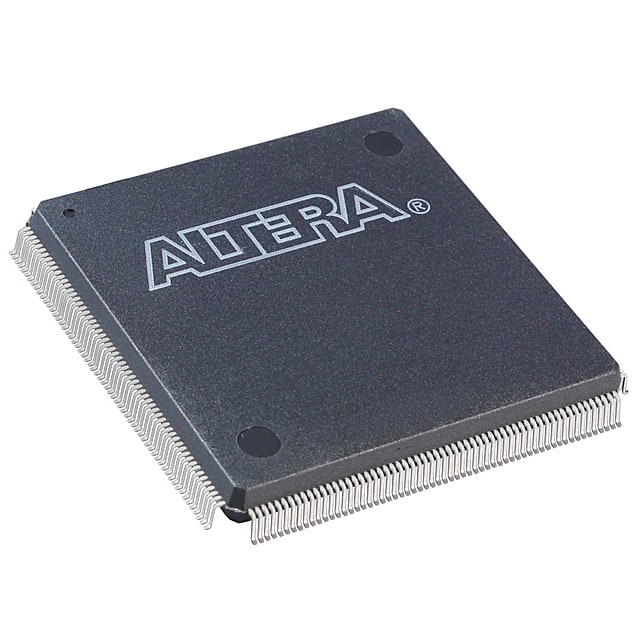EPF10K100EQC240-1N
Product Overview
Category: Programmable Logic Device (PLD)
Use: The EPF10K100EQC240-1N is a high-performance PLD designed for various digital logic applications. It offers flexible programmability and advanced features, making it suitable for a wide range of electronic systems.
Characteristics: - High-density integration - Low power consumption - Fast performance - Versatile functionality
Package: The EPF10K100EQC240-1N comes in a 240-pin Quad Flat Package (QFP), which provides ease of installation and compatibility with standard PCB designs.
Essence: This PLD is built to provide efficient and reliable digital logic processing capabilities, enabling the implementation of complex algorithms and control functions in electronic systems.
Packaging/Quantity: The EPF10K100EQC240-1N is typically sold individually or in reels, with each reel containing a specific quantity of devices.
Specifications
- Maximum Gates: 100,000
- Number of I/O Pins: 240
- Operating Voltage: 3.3V
- Operating Temperature Range: -40°C to 85°C
- Speed Grade: 1N (Fastest)
Detailed Pin Configuration
The EPF10K100EQC240-1N has a total of 240 pins, each serving a specific purpose in the device's operation. A detailed pin configuration diagram can be found in the product datasheet.
Functional Features
- Flexible Logic Blocks: The PLD consists of multiple logic blocks that can be programmed to perform various functions, allowing for customization and adaptability.
- Embedded Memory: The EPF10K100EQC240-1N includes on-chip memory elements, such as flip-flops and RAM, providing storage capabilities for data processing.
- I/O Flexibility: With 240 I/O pins, the PLD offers extensive connectivity options for interfacing with other electronic components and systems.
- Clock Management: The device incorporates advanced clock management features, enabling precise timing control and synchronization.
Advantages and Disadvantages
Advantages: - High integration density allows for complex designs in a compact form factor. - Low power consumption contributes to energy-efficient operation. - Fast performance enables real-time processing of data and control signals. - Versatile functionality supports a wide range of applications.
Disadvantages: - Limited availability of alternative models from other manufacturers. - Steep learning curve for programming and configuring the PLD.
Working Principles
The EPF10K100EQC240-1N operates based on the principles of programmable logic. It consists of configurable logic blocks interconnected through programmable interconnects. These logic blocks can be programmed using Hardware Description Languages (HDL) to implement desired digital logic functions. The PLD's internal memory elements store the configuration data, allowing for reprogramming as needed.
Detailed Application Field Plans
The EPF10K100EQC240-1N finds application in various fields, including: - Industrial automation - Telecommunications - Automotive electronics - Consumer electronics - Medical devices
In industrial automation, it can be used for control systems, motor drives, and robotics. In telecommunications, it can enable high-speed data processing and network switching. In automotive electronics, it can support advanced driver assistance systems (ADAS) and engine control units (ECUs). In consumer electronics, it can be utilized for multimedia devices and gaming consoles. In medical devices, it can aid in diagnostic equipment and patient monitoring systems.
Detailed and Complete Alternative Models
While the EPF10K100EQC240-1N is a highly capable PLD, there are alternative models available from other manufacturers that offer similar functionality. Some notable alternatives include: - Xilinx XC9500XL series - Altera MAX 7000 series - Lattice ispMACH 4000ZE series
These alternative models provide comparable features and performance, allowing designers to choose the most suitable PLD for their specific application requirements.
Word Count: 511
기술 솔루션에 EPF10K100EQC240-1N 적용과 관련된 10가지 일반적인 질문과 답변을 나열하세요.
What is EPF10K100EQC240-1N?
EPF10K100EQC240-1N is a field-programmable gate array (FPGA) manufactured by Intel.What are the key features of EPF10K100EQC240-1N?
EPF10K100EQC240-1N features 100,000 system gates, 3,840 logic elements, and 144 user I/O pins.How can EPF10K100EQC240-1N be used in technical solutions?
EPF10K100EQC240-1N can be used for digital signal processing, embedded systems, and high-performance computing applications.What tools are available for programming EPF10K100EQC240-1N?
Intel provides Quartus Prime software for programming and configuring EPF10K100EQC240-1N.Can EPF10K100EQC240-1N be reprogrammed after initial configuration?
Yes, EPF10K100EQC240-1N supports in-system programming (ISP) for reconfiguration.What are the power requirements for EPF10K100EQC240-1N?
EPF10K100EQC240-1N operates at a typical core voltage of 2.5V and I/O voltage of 3.3V.Is EPF10K100EQC240-1N suitable for industrial applications?
Yes, EPF10K100EQC240-1N is designed to meet the reliability and performance requirements of industrial applications.Can EPF10K100EQC240-1N interface with other components or devices?
EPF10K100EQC240-1N supports various communication protocols and can interface with external memory, sensors, and peripherals.Are there any design considerations when using EPF10K100EQC240-1N in high-speed applications?
Designers should consider signal integrity, timing constraints, and power distribution for high-speed applications using EPF10K100EQC240-1N.Where can I find additional resources and support for EPF10K100EQC240-1N?
Intel's website provides datasheets, application notes, and technical support for EPF10K100EQC240-1N.


